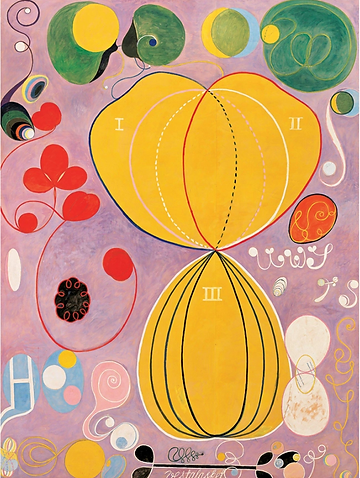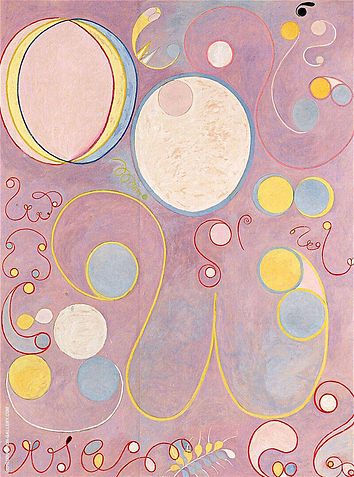Ekphrasis (noun)
“Description” in Greek. An ekphrastic poem is a vivid description of a scene or, more commonly, a work of art. Through the imaginative act of narrating and reflecting on the “action” of a painting or sculpture, the poet may amplify and expand its meaning."
The Artist Sends Her Regards


Hilma Af Klint
Group IV, The Ten Largest, No. 7 and 8, Adulthood, 1907, Tempera on paper, mounted on canvas
The Artist Sends Her Regards
I.
The art often outnumbers the artist and
In countless ways lives entirely separate from
The hands that make it.
We live no such life
Packed in
Unshared
Unseen by any but the sleep deprived eyes of our creator
And even she is not looking beyond her easel.
We lean against every wall of this house
Give the illusion that we make up its foundation
Eat up plaster and plywood until
All that’s left is ossified layers of canvas,
Skin grown around an antrum in which the artist resides.
We watch from the seams
As she works in a seance of paper and paint and ink stained cuticles
Swimming in incense that sticks and penetrates into our porous material
Every canvas she dances over for an interval
And the next naked surface leaps to her hands the minute brush leaves paper.
When her eyes refocus
Recalibrate themselves to the physical world,
She tells us a story - or maybe she speaks to herself - and
It's always the same one;
How the sun is not ready
Neither the people,
The same words we have heard since the very first stroke
Written across us in shapes and colors of the future -
Now is not our time.
Not yet.
Not yet.
Kandinsky;
Mondrian;
Malevich;
Kupka;
They will make history but
The artist is too busy making art -
Painting for the future;
Doesn’t care about history books’ authenticity
Will explicitly leave that to the historians.
For decades we will be the only ones to witness her art
Follow the mastery of her trained hand
Strip down a classical education for spare parts
Break rules and
Make wibbly wobbly circles out of lines she has been told not to cross.
The year is 1907.
In October 1944 a gear is thrown in the machine and
We see the artist wheeled away
No bouquet or
Grand ceremony,
She’s just there, then she’s not.
We are not so easily disposed of,
Huddled in corners,
But pulled apart to be packed away
Back to back,
Front to front,
No paint is to be chipped but
I doubt if anyone would much care if it was.
Darkness feels less sharp when
It’s full of so much hidden color
Shapes to unearth
Analyze
Revive for new eyes
But not for decades.
Years are spent in that soft darkness
Edges combatting the nibbling of days
Weeks
At last we are unearthed
Thanks to her words
The last she said
Immortalized in a will that means our survival
Our revival and exhibition
Our time at last.
The art often outnumbers the artist and
With skill outlives them too.
But neither are worth anything sealed in cement
Plastered in silence
Untouched and untouching -
If a tree falls in a forest and no one is around, it will make a sound but
Then it will be gone and the silence will live on unaffected.
We are better off as paving stones than
Packaged relics.
II.
2004.
A curly haired child runs screaming up the levels of the museum
Losing her parents and both gloves in the crowd,
But still laughing and
Singing aloud
She’s living in her own reality and
Can’t be bothered to stay quiet.
She worms her way through wool coats and
Colorful purses
Makes it all the way to the very top and then
Slips
Trips
Tumbles in a pile.
Startled she looks up
Is face to face with another world
Her twitching little nose centimeters from
Shapes that hear her song and sing right back.
Her eyes grow wide and
She falls back on her bottom, slides
Into a position of awe
Jaw staring open
Quiet for the first time since the very bottom floor.
A furrow-browed crowd gathers
Sees the small feet across a red tape line and
Not the glittering eyes attached to them
Doesn’t know what to do
Who to call
They are just as enthralled as she but
Altogether more annoyed.
There they all are as
The little girl pulls out a pink marker from her left boot
Pulls the cap off with her teeth
Starts sketching squiggles and circles across the cement floor
Her small frame imitating the adult-sized machine that made the original strokes.
The child giggles
The people gasp
The art smiles -
It has never seen an artist so young,
So easily in tune with the world,
and all without the incense or shallow trance through which it was born.
About Hilma af Klint
from the Guggenheim:
"When Hilma af Klint began creating radically abstract paintings in 1906, they were like little that had been seen before: bold, colorful, and untethered from any recognizable references to the physical world. It was years before Vasily Kandinsky, Kazimir Malevich, Piet Mondrian, and others would take similar strides to rid their own artwork of representational content. Yet while many of her better-known contemporaries published manifestos and exhibited widely, af Klint kept her groundbreaking paintings largely private. She rarely exhibited them and, convinced the world was not yet ready to understand her work, stipulated that it not be shown for twenty years following her death. Ultimately, her work was all but unseen until 1986, and only over the subsequent three decades have her paintings and works on paper begun to receive serious attention."
